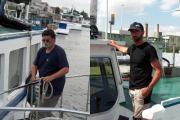
The JDS2 Fish Team has had their share of interesting, and often unexpected, discoveries and adventures. Here are a few examples, from Sampling Station 13 at Wildungsmauer-Hainburg, their last in Austria on August 13, to Station 50 in Belegish, Serbia on September 5. In many locations, they were assisted by National Fish Team colleagues.
High densities of invasive species continued to be found (see ‘Diary' story on August 26), especially non-native gobies. These included round goby (Neogobius melanostomus) at Station 13 (Wildungsmauer-Hainburg, Austria), and in the upstream part of the Gabcikovo reservoir along the rip-rap shorelines at Station 17 in Slovakia. At Station 18 (Medve, Hungary), high densities of non-native racer goby (Neogobius gymnotrachelus) were found in a side-arm. Around Station 26 in Szob, Hungary, the change in sediment composition from gravel- to sand-dominated banks led to high numbers of monkey goby (Neogobius fluviatilis), as well as record numbers of larval lampreys (Eudontomyzon mariae). At Station 32 downstream from Budapest, again several larval lampreys were found, this time in unusual places such as rip-rap. And at Station 50 near Belegish, Serbia, non-natives included gobies and pumpkinseed (Lepomis gibbosus). Interestingly, upstream from Mohacs, Hungary, one snagged bighead goby (Neogobius kessleri) was just about to swallow a large crayfish.
Interesting native discoveries included bitterling (Rhodeus sericeus) near Gabcikovo - a typical backwater species found in vegetated areas covered with reeds, famous for laying its eggs in mussels. Near Bratislava, several juvenile striped ruffe (Gymnocephalus schraetser), an endemic species of the Danube, were caught on a gravel bank. Sabre carp (Pelecus cultratus) were found near Medve and Szob in Hungary. In Szob, the first successful use of the drift net caught a sterlet (Acipenser ruthenus), and several white-finned gudgeon (Gobio albipinnatus) were also found. At Station 32 downstream from Budapest, the first specimens of Balcan loach (Sabanejewia aurata) were caught, as well as the smallest catch so far -- a 15 mm round goby.
Storms, waves and low waters
As for adventures, there were plenty. Heavy rains and thunderstorms often caused serious problems for the small Piscius boat, at times making fish sampling impossible, especially at night. Near Gabcikovo, night fishing had to be abandoned initially due to a rising thunderstorm -- afterwards, the team just managed to reach their sheltered harbour area in time. At Station 47 downstream from Novi Sad, Serbia, night sampling was made impossible because of a heavy rainfall and storm. Press events at major cities such as Vienna also caused (worthwhile) delays, as did crossing borders - as when the Piscius crossed from Hungary to Croatia.
A major surprise occurred when, on its way to Medve, the Piscius was suddenly overtaken by a large tugboat in the upstream channel of Gabcikovo going at reckless speed. The enormous waves, some over two meters high, even slammed over the dams of the navigation channel. On the Piscius, several dishes were broken and equipment on deck was lost. Miraculously, apart from a minor cut for the Core Team Leader, no one was injured. But all were left shaking their heads in disbelief.
Water levels at times made some spots inaccessible. For example, due to low waters, in the multi-island area upstream from Mohacs, Hungary, the side-arms were hardly accessible, so that boat sampling was mainly done in the main channel. At Station 30 at the Szentendre side-arm, also given low waters, the Core Team decided to use their drift net as a beach seine - but because of too many twigs and branches, only a few small fish, including juvenile Danube roach (Rutilus pigus), could be caught.
September 2 in Almjas, Croatia (near the city of Osijek) was a time for hello's and goodbyes, as the Fish Team welcomed new Core Team members, Romania's Grigore Davideanu and Hungary's Gabor Guti, on-board the ship. They replaced Austria's Nikolaus Schotzko and Slovakia's Jaroslav Cerny who said goodbye after three weeks of engaged work and scientific discussion. Fish Team Leader, Austria's Christian Wiesner, remained as the only member to go from JDS2 start to finish.















